The limited range of CB radios, has forever, been the Achilles Heel for the CBers. But you don’t have to stay satisfied with what you have. You can always squeeze out high-quality signals from your CB radio with a CB linear amplifier.
If you are thinking of making a purchase and you don’t know where to start, I have rounded up a list of 9 best CB linear amplifiers that you can invest your money on. It is not just any random list. It is a compilation that reflects hours of test results
Topics Covered:
5 Best CB Linear Amplifiers
The market will blast you will multiple choices, and it can become overwhelming to select the best one. I have thoroughly tested several of the famous CB linear amplifiers over days and finally settled for five of them that will give you the best performance and best value for more.
Let’s begin with the list!
#1. MegaWatt S-400-12 – Exceptional Build Quality with Clean and Stable Output
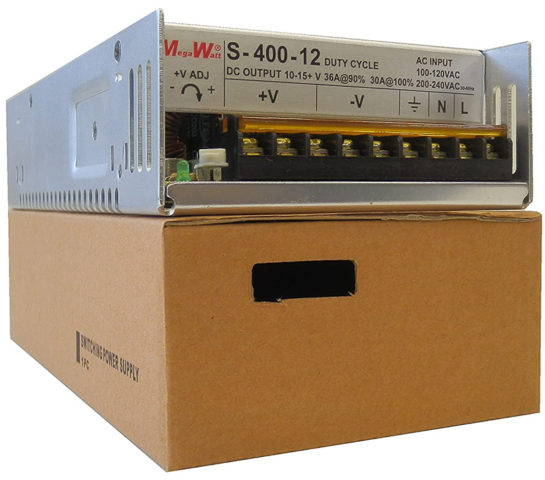
MegaWatt S-400-12 Technical Specifications:
| Amplifier Name | MegaWatt S-400-12 |
|---|---|
| Wattage | 450 Watts |
| Output Voltage | 9.5 volts DC to 15+ volts DC |
| Heat Management | Fans |
| Noise Elimination | Eliminates RF Noise |
MegaWatt S-400-12 Linear Radio Amplifier Review
After testing for days and pitching it against many other CB linear amplifier options available in the market, I found MegaWatt S-400 as one of the best that your money can buy.
MegaWatt S-400 amplifier is an affordable power booster, one of the best build qualities and far superior to other linear amplifiers. I would suggest this to anyone who’s looking to buy the best CB linear amplifier.
John
MegaWatt S-400-12 has a clean and stable output with a highly filtered and regulated structure for RF noise elimination in audio equipment and radio. It requires only 12 volts of power supply for its exemplary performance. That’s very much within the FCC regulations.
The manufacturer did a remarkable job of maintaining voltage stability for the MegaWatt S-400-12 device. It also comes with protection against unexpected power surges, a grounded power cord, and an automatic shut down for protection against short circuit.
As far as the cooling mechanism is concerned, this unit has mounted fans that are silent enough not to cause annoyance. They keep running slowly always and consistently dissipate the heat in the surroundings.
The MegaWatt S-400-12 unit allows adjusting the output from 9.5 volts DC to more than 15 volts DC. If you have 13.8-volt equipment, it is a great choice. If you have a piece of 12-volt equipment, you can still use this CB linear amplifier.
#2. MegaWatt S-350-12 – Best Value for Money
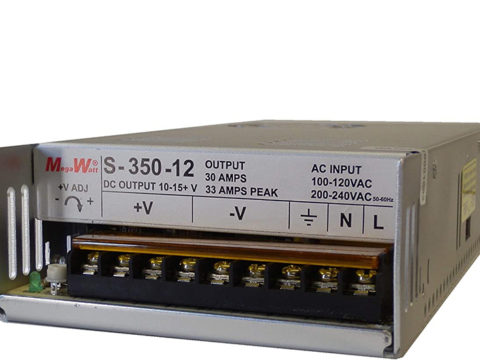
MegaWatt S-350-12 Technical Specifications
| Amplifier Name | MegaWatt S-400-12 |
|---|---|
| Wattage | 450 Watts |
| Output Voltage | 9.5 volts DC to 15+ volts DC |
| Heat Management | Fans |
| Noise Elimination | Eliminates RF Noise |
MegaWatt S-350-12 CB Linear Amplifier Review
If you don’t need 450 watts of power, but still want to go for something that offers truly stable output, I will suggest you check out the MegaWatt S-350-12. Yes, it is a scaled-down version with almost the same specifications.
If budget is your concern, then buy MegaWatt S-350-12. Otherwise, it’s better to buy the MegaWatt S-450-12 model as it offers 450 watts output.
John
Considering its small price, the MegaWatt S-350-12 is big on features. One of the finest features that I like about this model is its ability to clear out RF noise. It does so like a pro.
The MegaWatt S-350-12 amplifier comes with an adjustable output of 9.5 volts to 15 volts DC, making it a suitable option for gear up to 13.8 volts. That shouldn’t deter you from using it with equipment that draws 33 amps to less at 12 volts. The S-350-12 will work great with such equipment.
Complete with a grounded power cord and double ball bearing power supplies, this CB linear amplifier will work great even with your Ham radio. Do keep in mind that the input has to be within 120 and 240 volts.
If you are worried about the protection features, MegaWatt has you covered. It has over-voltage protection and has an automatic short circuit shut down protection.
#3. MFJ-264 – Best Highly Adaptable Dummy Load
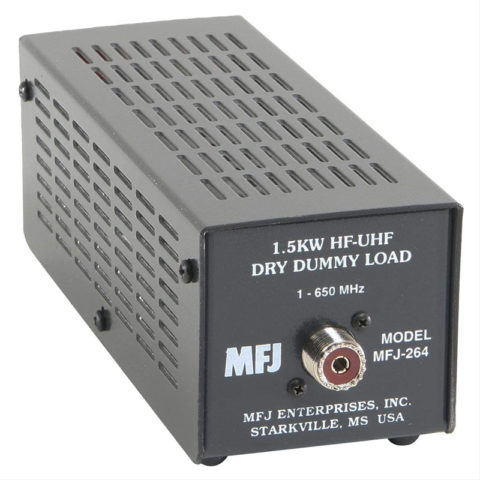
MFJ-264 Technical Specifications
| Amplifier Name | MFJ-264 |
|---|---|
| Wattage | 1500 Watts |
| Output Voltage | 100 watts for 10 minutes and 1500 watts for 10 seconds |
| Heat Management | Air-cooled |
| Noise Elimination | No |
MFJ-264 CB Linear Radio Amplifier Review
With remarkably strong and super lightweight aluminum construction, the MFJ-264 is the best in class CB linear amplifier if you are looking for a dry dummy load.
Designed to work for all radios from 160 mete1 MHz through 650 MHz, this CB linear amplifier is a monster despite its small size. With an air-cooling mechanism, the MFJ-264 is capable of handling 100 watts for 10 minutes straight. It can work with 1500 watts for a maximum of 10 seconds.
It comes with a SO-239 connector and has a voltage gradient of 10kV/inch. You can operate this thing up to 350 degrees Celsius. It can operate from QRP (transmitting at reduced power) to 1500 watts of the legal limit.
#4. MFJ-260C – Best Compact and Mobile CB Linear Amplifier
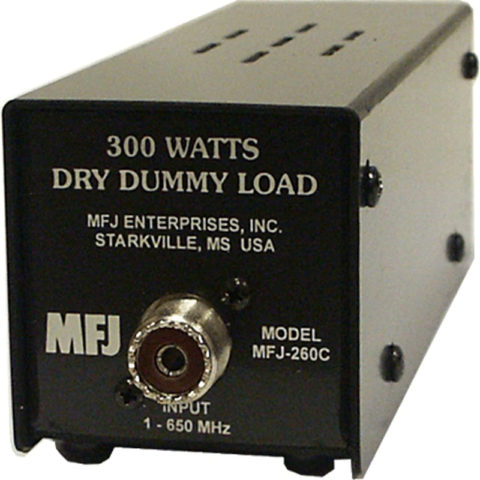
MFJ-260C Technical Specifications
| Amplifier Name | MFJ-260C |
|---|---|
| Wattage | 300 Watts |
| Output Voltage | 300 watts for 30 seconds |
| Heat Management | Air-cooled |
| Noise Elimination | No |
MFJ-260C – Compact CB Linear Amplifier Review
If you need a CB linear amplifier to test your ham or CB radio, the 300-watt MFJ-260C is the next-best pocket-friendly option that you can get. With a maximum wattage of 300 watts, this unit is housed in a perforated metal casing.
It is one of the finest dry dummy load amplifiers that I have tested so far. It is super compact and is easy to carry around. Its operational capabilities include 30 seconds of operation under a full 300-watt load.
For lower loads, this unit can run up to 5 minutes continuously. It comes with a PL-259 connector and works fine with all radios within 1 MHz and 650 MHz range. It will allow up to 20 feet of transmission for a 5-watt transceiver.
#5. HYS TC-300N – Works with AM, FM, and SSB
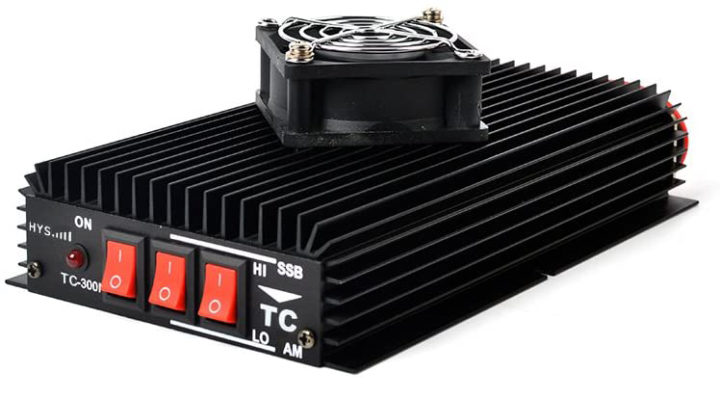
HYS TC-300N Technical Specifications
| Amplifier Name | HYS TC-300N |
|---|---|
| Wattage | 300 Watts |
| Output Voltage | 150 watts for AM and FM, 300 watts for SSB |
| Heat Management | Air-cooled and heat sink |
| Noise Elimination | No |
HYS TC-300N AM and FM CB Radio Linear Amplifier
The HYS TC-300N CB linear amplifier is one of the best. It works great with portable two-way radios and walkie-talkies in the range of 3 MHz and 30 MHz. However, if you really want the best out of it, make it work in the 20 MHz and 30 MHz range.
At that optimal range, the device has maximum heat dissipation. Talking of heat dissipation, the whole body of the amplifier has a heat sink type design with an extra fan to pull out the heat.
For AM and FM mode, the general output range for the amp is 100 watts, but the maximum output is 150 at 10W input. The minimum input it accepts for AM and FM is 1 watt.
For SSB, the maximum output is 300 watts for 10 watts of input. If the input drops to 5 watts, the maximum output for SSB is 250 watts. The minimum allowed input for SSB is 2 watts.
For easy accessibility, the amplifier comes with neatly arranged Tx/Rx and ON/OFF switches on the front. It also comes with built-in reverse polarity protection, something that you won’t find so easily.

How to Choose the Best CB Linear Amplifier?
Shopping for CB linear amplifiers is not an easy task. There are different factors that you need to consider. Here is what you should be looking for:
A. Compatibility
Compatibility is by far the most important aspect to consider when purchasing a CB linear amplifier. You need to have a sound knowledge of FCC regulations.
FCC rules dictate that your CB radio should have a power output within 4 Watts and 12 Watts. This means that the input power of your CB linear amplifier should always be within that range.
Additionally, remember that the frequency range should be 20 MHz to 30 MHz. That’s the range allowed for CB radios. So, you should select an amplifier that maintains this nitty-gritty.
B. Amplification
I don’t need to explain this one, do I? The reason why you are purchasing an amplifier is to amplify the sound. The more, the better! So, settle for the one that amplifies the sound as promised.
C. Cooling Features
Amplifiers, upon extended use, can heat up pretty quickly. When an amplifier heats up, performance degrades. In the worst-case scenarios, excessive heating can melt some of the internal components.
So, you need to ensure that whichever amplifier you are purchasing has proper heat disposal features. There should be heat sinks and mounted fans to extract and dissipate the heat in the surrounding atmosphere.
D. Advanced Features
Again, there isn’t enough to explain here. You should, preferably, settle for an amplifier with some advanced features like over-voltage shut down protection and auto short circuit protection.
Also, look for an amplifier that has reverse polarity protection. Polarity reversal can cause immense damage to the amplifier. That’s the reason why most of the amplifiers that you can find today come with the safeguard.
These features will ensure that your amplifier gives optimal performance while staying protected. These features may increase the price of an amplifier, but in the long run, they can turn out to be real money savers.
E. Modes
The rule of thumb here is that the more modes your amplifier has, the better it is. Fortunately, almost every CB linear amplifier you find in the market is stuffed with all modes. Still, it is always a good idea to check before you make a purchase.
F. Noise Cancellation
Though it is not a necessity, having the noise cancellation feature in your amplifier will help you to suppress the background noise that comes in the absence of signals. This background noise can be annoying, and keeping it suppressed will keep your receiver silent.
If the background noise doesn’t bother you, you can settle for an amplifier that doesn’t offer this feature.
G. Output Power
An amplifier should be capable of increasing the output power during the transmission of signals. In general, output power should be above 150 watts. Even 100 watts will work just fine, depending on what type of range you want to achieve. Just ensure that the output power is never below 100 watts.
Luckily, most of the CB radio amps in the market offers 150 watts or more. Just ensure that you are checking this before you buy one.
H. Portability
Most likely, you won’t find a CB radio amplifier that is too bulky and difficult to carry around. Today’s amplifiers are small and lightweight. They will not interfere with the usage. You can put the amplifier on the floor or even underneath the radio, and if necessary, easily carry it around.
I. Design
The design of a CB linear amplifier is one of the most fundamental aspects. A well-designed amp should focus on at least three things, which are:
- Ventilators and radiators or any other cooling mechanism must be available.
- There should be proper placement of important parts like buttons, cable connectors, etc.
- There should be some sort of self-protective feature built into the unit. For instance, you should particularly look for reverse polarity protection.
J. Price
I keep saying this again and again. You should know your budget properly. Understand one thing very clearly. The more price you pay, the better quality and better technical specifications you get. Do not expect very high quality for a very low price.
Having said that, you need to understand that even a highly-priced item may not be of great quality. So, do some research on the brand you want to purchase and go through the different online reviews you find.
Of course, many of those reviews are paid reviews, which means that the companies paid a hefty price to make people write nice things about them.
CB Linear Amplifier FAQ
There are a set of basic questions that people always keep asking. You should know the answers to those questions because they often have tiny details hidden that can greatly benefit you.
Let’s begin!
What is a CB Linear amplifier?
A CB linear amplifier or a CB radio amplifier is a device that will increase the output of a standard CB radio (which typically has a power output of 4 watts) by manifolds. If the standard CB radio that you have allows you to talk within your town, an amplifier may very well allow you to talk to people in the next town. Here are some of the best CB Linear Amplifiers.
1. MegaWatt S-400-12 – Exceptional Build Quality with Clean and Stable Output
2. MegaWatt S-350-12 – Best Value for Money
3. MFJ-264 – Best Highly Adaptable Dummy Load
4. MFJ-260C – Best Compact and Mobile CB Linear Amplifier
5. HYS TC-300N – Works with AM, FM, and SSB
Are CB Linear amplifiers legal?
CB Linear Amplifiers are illegal. Theoretically, if you ignore the FCC rules, you will have to pay a hefty fine. In the worst-case scenario, you will have to face jail time. Again, that’s the theory! But CB amplifiers may be legal in the place where you live. It is illegal to use CB radios in several places in America and the world. That, however, has never stopped many CBers from using an amplifier. Theoretically, they can be fined or jailed, but that rarely happens. Still, be safe! Even if you are using a linear amplifier for your CB radio, make sure that you are staying within the permissible power range. If you get too bold and settle for a linear amplifier with a 1000-watt power output or more, you will invariably get into trouble. So, do some study, and talk to your fellow CBers before you invest your money in an amplifier.
How much power should an amplifier ideally have?
A normal 4-watt CB radio will give you a range of up to 20 miles in ideal conditions. The amplifier you buy should depend on how far you want to reach. If your target is to reach about 65 to 70 miles, a 100-watt amplifier should work perfectly fine.
How to take care of a CB amplifier?
CB amplifiers are electrical devices. They are plagued with similar problems that other electrical devices face. So, taking care of your CB linear amplifier is important. Here are some basic tips that you need to follow:
- Keep your amp in a well-ventilated room or place. Remember that CB amps can heat up quickly. Even if there are proper heat management options in place, you may be surprised to see how a poorly-ventilated room can lead to device malfunctioning because of heating issues.
- Keep it away from water! A CB amp is an electronic device. Keeping it close to water or in contact with water can lead to accidents.
- When not in use, detach the amp from the power source.
- Do not keep your amplifier covered during usage. It will lead to a heating problem.
- Keep your amplifier covered with a piece of cloth when it is not in use. This will prevent dust accumulation.
- Keep your amplifier away from areas of ant and insect infestation. They can build nests inside the amplifier and destroy the circuits.
Can I use any wattage for CB Linear Amplifier?
Ideally, your amp should not have more than 150 watts, and neither should it be below 100 watts. It is not uncommon to find amps that offer 250 watts or 300 watts or even more. Just because such high wattage is available, you don’t need to buy one. It may be the case that your antenna is set for handling only 150 watts. If you send 300 watts, you are bound to run into trouble.
You need to understand that amplifiers need a large amount of electricity for powering up an antenna, but again, your antenna will also have a limit of how much input it can take. Looking the other way round, your amplifier should be able to withstand the input from your radio to avoid damage. Make sure that you are using an amplifier that is compatible with the radio that you have.
Do I need an amplifier that goes beyond 450 watts?
The maximum practical gain that you can receive in the distance is when you use a 450-watt amplifier. It is pointless to opt for an amplifier of more than 450 watts. If you want to achieve that, a 500-watt amp should suffice.
Should I use a 1000-watt or a 3000-watt amplifier?
No, you should not. That will be a wastage of power. Not only that, using such an amplifier will cause immense interference to telephones, radios, and televisions nearby. What that happens, be ready to greet some FCC officials who will be there to school you and impose a hefty fine on you. Your aim should be to buy an amplifier that has the minimum required power to achieve a distance gain that you desire.
What is the ideal CB linear amplifier?
Umm… it should ideally be the one that FCC can never come to know about! Gotcha! That was a joke!
FCC will know even if you are using a standard CB radio. The moment you hook up an amplifier, there is no way you can hide your deed.
Coming to the point, the idea CB linear amplifier should be independent of frequency, should maintain a constant gain at various input signal values, and should not add noise.
Also, a good CB amplifier should not have performance issues when the surrounding temperatures change, and it should be capable of working for long hours if without heating up significantly.
Can I make a CB amplifier at home?
Yes, you can! You need to have the proper know-how. Necessary electrical parts should be at your disposal, and you should know the function of each one of those parts. Of course, there are tutorials available on the internet that you can use to build one amplifier from scratch. However, if you are not sure enough, I will always suggest that you purchase one.
What are the different types of CB amplifiers?
Before you head out for purchasing a CB amplifier, you need to know that there are different types available. For instance, there is a class of amplifiers that can amplify the sound. Then there are others that will amplify the signals. So, the choice of your CB amplifier should always depend on what you need!
The commonest amplifier types that you will come across are:
- Common-emitter amplifiers.
- Valve RF amplifiers.
- CB linear amplifiers.
If your antenna is picking up the signal poorly, you will need a common-emitter amplifier. These ones enhance and amplify feeble or weak signals picked up by your antenna.
In case you want to amplify the power of any radio frequency signal, you will need the valve RF amplifier. Valve RF amplifiers are commonly used for high-power transmitters.
The CB linear amplifier is the most powerful of all. These are designed for reconditioning the outgoing signals. These are the best in the market because they are not only capable of providing the best performance but also increase the coverage distance with high power.
There is another form of classification available. Under this classification system, you will get Class A, Class B, Class AB1, Class AB2, and Class C. In short, Class A amplifiers give great signals but less efficiency. As you move up through Class B to Class C, the signal quality will drop, but the efficiency will increase.
There is a lot of technical stuff in here, and hence, I will skip the explanation. I don’t want to make things overly complicated for you.
The bottom line is that if you are looking for a CB amplifier, go for a CB linear amplifier. That is what will give you the best performance.
Also read, Best CB Radio.
Topics Covered - Index
External Resources and Manufacturer Links
- http://www.megawattpowersupplies.com/
- https://mfjenterprises.com/
- https://en.wikipedia.org/wiki/Amplifier
- https://en.wikipedia.org/wiki/Linear_amplifier
- FCC regulations on Communication
- Amplifiers operations tutorial
- Steps to build an Amplifier
That is all for today about about CB Linear Radio amplifiers. Feel free to read more article about,